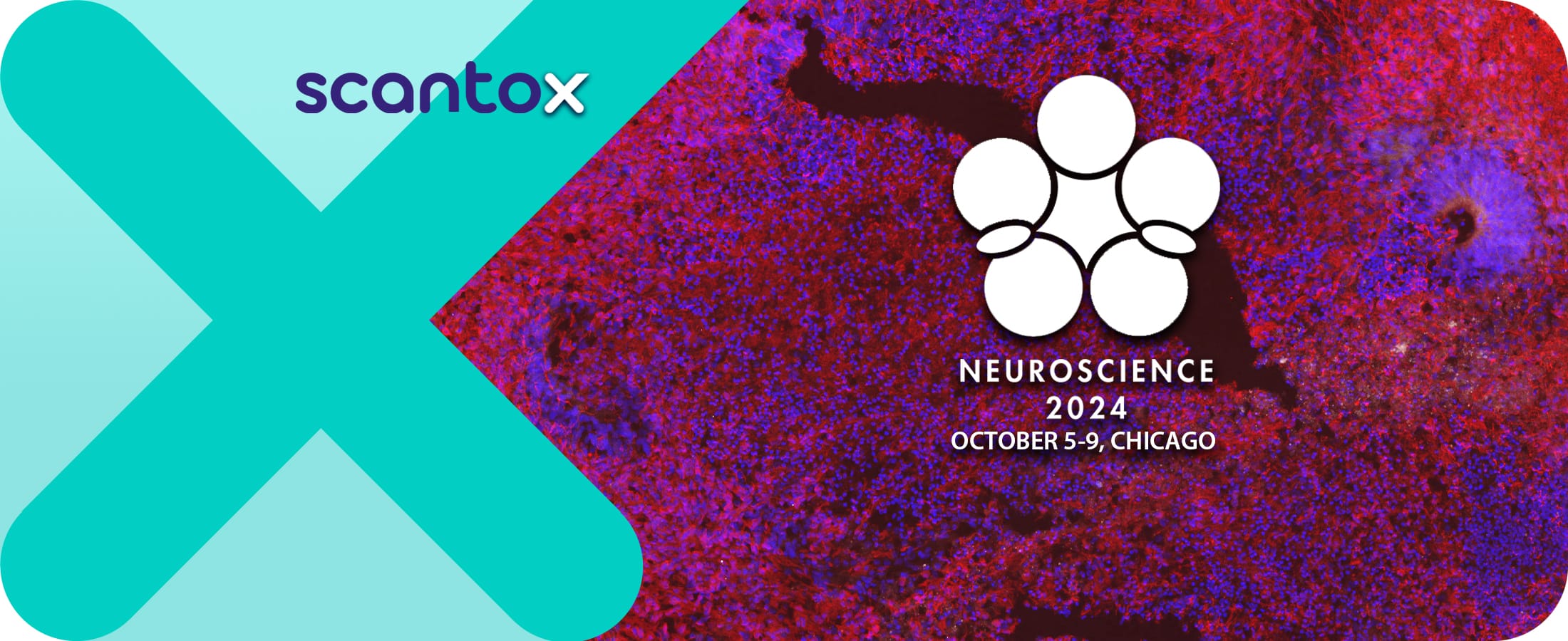We’re delighted to invite you to explore Scantox’s latest R&D advancements, including our work with stunning iPSC-derived brain organoids, at this year’s Society for Neuroscience (SfN) meeting. Join us in Chicago from 5 to 9 October for an inspiring gathering in the fast-moving field of neuroscience.
SfN’s annual meeting brings together thousands of scientists and clinicians passionate about everything from basic neuroscience research to advanced clinical applications. The event covers a wide range of topics, including groundbreaking research and the latest technological advances in studying the brain and nervous system.
Scantox’s Contributions
As a leading neuropharmacology CRO, Scantox will showcase its comprehensive range of preclinical model systems at booth N° 539. Our top scientific and business leaders will also present four posters highlighting our key service lines, including an in vitro assay model, an organoid system model, and two in vivo models.
In vitro systems targeting TDP-43 translocation, aggregation, and stathmin-2 splicing
This in vitro model:
- Investigates ALS mechanisms and TDP-43’s impact on stathmin-2 mRNA expression
- Allows the evaluation of therapeutic modalities against TDP-43 dysfunction
- Has been extended to iPSC-derived neurons and co-cultures for broader insights
Accelerated aging and senescence in cerebral organoids
This ex vivo model:
- Mimics brain-like organoids derived from human iPSCs
- Uses D-galactose treatment to trigger senescence, reducing organoid size and increasing aging markers
- Accelerates drug testing of anti-aging therapies
Modeling depression in rats: chronic corticosterone administration as a tool for antidepressant efficacy assessment
This in vivo model:
- Uses corticosterone treatments in rats to simulate depressive-like symptoms and study depression’s mechanisms
- Fosters the understanding of pathogenesis and testing potential treatments, such as the antidepressant fluoxetine
AAV-human A53T-mutated synuclein disrupts nigro-striatal system in mice
This induced mouse model:
- Features the A53T α-synuclein mutation, closely replicating Parkinson’s disease pathology
- Uses targeted AAV vector injection into the substantia nigra resulting in increased α-synuclein phosphorylation and reduced dopaminergic neurons mimicking disease progression
- Provides comprehensive insights into synucleinopathies and aids in developing targeted therapies
Validated Preclinical Model Systems and Their Impact
Our posters show that our innovative preclinical model systems are crucial for advancing therapeutic modalities. Tina Loeffler, Head of In Vitro Research, explains the significance of our approach: “At Scantox, we are driven by a science-first approach. Our focus is developing novel, comprehensive assay solutions for various neurological conditions and rigorous in-house validation. This ensures our partners have access to the most reliable and effective tools for neuroscience research and accurate data.”
Join Us for a Deep Dive into Neuroscience
If you value scientist-to-scientist engagement backed by extensive experience and technical skills in neuropharmacology research, schedule a meeting with our experts, Andy Brown (CCO), Ewald Auer (BD Director), Lone Bruhn Madsen (CSO) or Tina Loeffler and join us at booth N°539. Also, do not miss the interactive poster sessions, where you can discuss your research projects, gain new insights, and learn more about our preclinical model systems and approach to data.
Experience how our scientists provide customized solutions to propel your drug development efforts forward!











